Week 1: October 31 – November 6, 2010
|
|
| THIS WEEK | THIS WINTER | 2010 TOTAL | SITE TOTAL | |
|---|---|---|---|---|
| # birds (and species) banded | 235 (14) | 235 (14) | 7917 (81) | 31426 (106) |
| # birds (and species) repeat | 17 (6) | 17 (6) | 1115 (52) | 5456 (68) |
| # birds (and species) return | 6 (3) | 6 (3) | 182 (33) | 802 (37) |
| # species observed | 33 | 33 | 161 | 202 |
| # net hours | 50.2 | 50.2 | 9650.9 | 49558.1 |
| # birds banded / 100 net hours | 468.0 | 468.0 | 82.0 | 63.4 |
Note: table does not include nocturnal banding (owls)
Banders-in-charge: Simon Duval, Gay Gruner, Kristen Keyes Assistants: Bob Barnhurst, Megan Chan, Jean Demers, Leah Den Besten, Amélie Drolet, Karine Duffy, Marie-Line Gentes, Diana Kirkwood, Betsy McFarlane, France Millette, Marissa Nolan, Melissa Scerbo, Jane Sorensen, Clémence Soulard, Bonnie Soutar, Rodger Titman
Notes: Last year at this time we left the fall nets up for an extra week to see whether we were missing the tail end of migration for sparrows and other late-moving species, and ended up with just a trickle of birds (28 individuals) in 157 net hours. This year we returned to our traditional approach of shutting down the fall nets after 13 weeks and switching to the winter nets, and the count was almost tenfold greater, although our effort in terms of net hours was less than one third of our 2009 total. Of course in large part the birds we are catching now (and through the rest of winter) are being attracted to the feeders that are back in place and well-stocked, again thanks to the generous donation of seeds from the Centre de Conservation de la Faune Ailée.
Owling also continued this week, with the end of our official six-week season coming on Friday night, although it was somewhat anticlimactic, as it and the night before were both rained out. However, earlier in the week results were decent, with 11 more saw-whets banded, including an impressive late-season total of 6 on November 3. The total count for the past six weeks now stands at 109 saw-whets and 1 screech owl banded, plus two foreign recaptures. However, since the last night prior to the rain was so productive, we are going to continue on a part-time basis for at least one more week to see whether we can determine when the saw-whet migration is really over. Any further results will be noted in the monthly report for November.
| # individuals banded | mean # individuals observed daily |
|---|---|
| 1. Slate-coloured Junco (98) [3] | 1. Canada Goose (387) [3] |
| 2. American Goldfinch (54) [5] | 2. American Crow (113) [5] |
| 3. House Finch (42) [10] | 3. European Starling (97) [10] |
| 4. American Tree Sparrow (17) [4] | 4. Slate-colored Junco (67) [3] |
| 5. Black-capped Chickadee (6) [2] | 5. House Finch (38) [-] |
| 5. White-throated Sparrow (6) [5] | 6. American Goldfinch (32) [6] |
| 7. Fox Sparrow (4) [5] | 7. Black-capped Chickadee (21) [7] |
| 8. Northern Cardinal (2) [-] | 8. Mallard (16) [8] |
| 9. Ring-billed Gull (13) [-] | |
| 10. American Tree Sparrow (11) [-] |
Clearly this year’s strong junco migration is continuing into November, with nearly 100 more banded this week, on top of the record total of 509 banded earlier this fall. On the other hand, despite the lure of the feeders, we banded very few chickadees this week, suggesting that the strong migration which continued through most of the final week of fall ended abruptly. It is less surprising that last week’s most banded bird, American Robin, was not banded at all this week, since it is unlikely to be attracted to the feeders (although we did catch a couple in the winter nets last year, probably attracted to the fruit remaining on the hawthorns there). Like last year, large numbers of American Goldfinches and House Finches arrived soon after the feeders went up, as reflected by the large numbers banded this week. Not listed in the table are the six species tied for ninth place with one individual banded each, including our first Common Redpoll of the year.
The list of species observed changed quite substantially from last week, most notably with the top two species (Red-winged Blackbird and American Robin) falling completely out of the top ten. leaving room for Canada Goose and American Crow to be the top two this week, as is typical for November. While the disappearance of the blackbirds and robins supports our policy of cutting off fall migration monitoring at the end of October, the juncos were this week clearly still migrating in large numbers. The highest new entry on the list this week was House Finch, no doubt linked to the recent reinstallation of the feeders.
In all, the 33 species observed this week were somewhat fewer than last year’s 39 during the same period, but still a good number considering that our five-year average for November as a whole is only 34 species. For the remainder of the season we will return to posting one update per month, then will resume with weekly reports when the spring season begins at the end of March.
|
|
November 7 – 30, 2010
PICTURE OF THE MONTH: |
|
|
|
MBO |
| THIS PERIOD | THIS WINTER | 2010 TOTAL | SITE TOTAL | |
|---|---|---|---|---|
| # birds (and species) banded | 143 (12) | 378 (18) | 8060 (81) | 31569 (106) |
| # birds (and species) repeat | 51 (7) | 68 (8) | 1166 (52) | 5507 (68) |
| # birds (and species) return | 5 (3) | 11 (4) | 187 (33) | 807 (37) |
| # species observed | 28 | 40 | 162 | 202 |
| # net hours | 59.0 | 109.0 | 9709.9 | 49617.1 |
| # birds banded / 100 net hours | 242.4 | 346.8 | 83.0 | 63.6 |
Note: table does not include nocturnal banding (owls)
Banders-in-charge: Simon Duval, Gay Gruner, Kristen Keyes Assistants: Rob Baker, Bob Barnhurst, Leah den Besten, Jean Demers, Amélie Drolet, Besty McFarlane, Greg Rand, Clémence Soulard, Bonnie Soutar, Rodger Titman
Notes: The pace of banding settled down compared to the first week of winter, while the number of repeats increased substantially, reflecting birds settling in for the winter. We still banded another 143 birds during four banding sessions spread across three weeks. This brings our total for November to 377 individuals, already more than we’ve ever banded in an entire winter.
Owling continued until November 13, but the migration was clearly tapering off toward the end. The final totals for the season were 122 Northern Saw-whet Owls banded, plus 2 foreign recaptures, plus 2 Eastern Screech-Owls, the second of which was the only bird banded on the final night of the season. Click here for a summary of the 2010 owling season.
| # individuals banded | mean # individuals observed daily |
|---|---|
| 1. Slate-coloured Junco (49) [1] | 1. Canada Goose (584) [1] |
| 2. American Goldfinch (39) [2] | 2. American Crow (44) [2] |
| 3. Black-capped Chickadee (20) [5] | 3. Mallard (32) [8] |
| 4. House Finch (19) [3] | 4. House Finch (29) [5] |
| 5. White-throated Sparrow (5) [5] | 5. Slate-colored Junco (23) [4] |
| 6. American Tree Sparrow (4) [4] | 6. Black-capped Chickadee (20) [7] |
| 7. Fox Sparrow (2) [7] | 7. American Goldfinch (14) [6] |
| 8. Ring-billed Gull (9) [9] | |
| 9. European Starling (6) [3] | |
| 10. Blue Jay (5) [-] |
Juncos and goldfinches remained in the top two spots this week by a wide margin over all other species banded, although numbers of both were down compared to the first week of November. On the other hand, the chickadees rebounded to third place, after only six were banded in the first week of winter. House Finch and the three sparrows rounding out the list were also down in numbers a bit, though the number of White-throated Sparrows was quite impressive for this late in fall. An additional five species tied for eighth place, with one bird banded each. The distribution of repeats during this period was also interesting, with 20 juncos and 20 chickadees suggesting that those two species are settling in as regulars at our feeders, compared to just 2 goldfinches (despite 93 being banded over the course of the month). We did, however, have one goldfinch return from a previous winter, as well as three chickadees and a Blue Jay.
Among species observed, Canada Goose continued to dominate by an enormous margin, thanks to large flocks flying overhead most days. Crows remained in second place, while Mallard jumped to third, followed by the core species at the feeders: House Finch, Slate-colored Junco, Black-capped Chickadee, and American Goldfinch. Overall the list is quite typical for November at MBO.
We have now banded 8059 birds this year, by far a record for MBO, and a total we might not be able to match again for years to come; factoring in repeats and returns, we had nearly 9500 captures in 2010. We will take a break from banding in December, allowing us time to review our data from the year and submit our annual report to the Canadian Bird Banding Office. Weather permitting, we will resume banding later in winter. In the meantime, we will continue with periodic visits to observe the wintering birds, and will post monthly updates on our observations.
|
|
December 2010
PICTURE OF THE MONTH: |
|
|
|
MBO |
| THIS PERIOD | THIS WINTER | 2010 TOTAL | SITE TOTAL | |
|---|---|---|---|---|
| # birds (and species) banded | — | 378 (18) | 8060 (81) | 31569 (106) |
| # birds (and species) repeat | — | 68 (8) | 1166 (52) | 5507 (68) |
| # birds (and species) return | — | 11 (4) | 187 (33) | 807 (37) |
| # species observed | 14 | 40 | 162 | 202 |
| # net hours | — | 109.0 | 9709.9 | 49617.1 |
| # birds banded / 100 net hours | n/a | 346.8 | 83.0 | 63.6 |
Note: table does not include nocturnal banding (owls)
Banders-in-charge: Simon Duval, Gay Gruner
Assistants: Greg Rand
Notes: After a record busy year at MBO, we decided to largely take December off, aside from keeping the feeders stocked for our feathered friends. We only collected formal observations once during the month, on December 20, when small numbers of 14 species were present.
| # individuals banded | mean # individuals observed daily |
|---|---|
| 1. Black-capped Chickadee (9) [6] | |
| 2. American Crow (8) [2] | |
| 3. Slate-colored Junco (6) [5] | |
| 4. Blue Jay (3) [10] | |
| 5. American Goldfinch (2) [7] | |
| 5. White-throated Sparrow (2) [-] | |
| 5. Hairy Woodpecker (2) [-] |
With only one day of observations, the top observations of the month are of course entirely biased by what we happened to see that day. However, the presence of chickadees and juncos within the top three is quite representative of this winter to date, based on anecdotal observations around the feeders.
To all our readers, thank you for your interest in our reports, and we look forward to sharing more exciting news from MBO in the new year! If you haven’t yet had an opportunity to review our first five-year report, we encourage you to download a copy by clicking here (15 MB file, PDF).
|
|
January 2011
PICTURE OF THE MONTH: |
|
|
|
MBO |
| THIS PERIOD | THIS WINTER | 2011 TOTAL | SITE TOTAL | |
|---|---|---|---|---|
| # birds (and species) banded | — | 378 (18) | — | 31569 (106) |
| # birds (and species) repeat | — | 68 (8) | — | 5507 (68) |
| # birds (and species) return | — | 11 (4) | — | 807 (37) |
| # species observed | 25 | 44 | 25 | 202 |
| # net hours | — | 109.0 | — | 49617.1 |
| # birds banded / 100 net hours | n/a | 346.8 | n/a | 63.6 |
Note: table does not include nocturnal banding (owls)
Observers: Gay Gruner, Chris Murphy, Greg Rand
Notes: 2011 at MBO got off to a relatively slow start, with just four species observed during our first visit on January 3. However, over the course of a dozen visits this month, the species count grew to a total of 25, including four seen for the first time this winter: Sharp-shinned Hawk, Golden-crowned Kinglet, and both Bohemian and Cedar Waxwings. The kinglet was the first one ever observed at MBO in January. Only four species were observed on all visits this month: Black-capped Chickadee, American Tree Sparrow, Slate-colored Junco, and American Goldfinch. Unfortunately it remained cold throughout the month, so there were no opportunities for winter banding, but we hope to have an opportunity for that in February.
| # individuals banded | mean # individuals observed daily |
|---|---|
| 1. Black-capped Chickadee (18) [1] | |
| 2. Cedar Waxwing (17) [-] | |
| 3. Slate-colored Junco (13) [3] | |
| 4. Bohemian Waxwing (12) [-] | |
| 5. European Starling (9) [-] |
Black-capped Chickadee and Slate-colored Junco remained in the top three, typical both for January and for this winter overall. The big surprise was Cedar Waxwing in second place, since this marks only the second time in seven winters that we have observed them in January at all. A modest group of six was first observed on January 11, then larger numbers were observed on all five visits between January 19 and 29, with counts between 32 and 69 on four of those dates. Meanwhile Bohemian Waxwings peaked from 35 to 60 individuals between January 6 and 19, then tapered off with only two lone individuals later in the month – also a bit surprising since traditionally their numbers at MBO peak in late winter. European Starling rounded out the top five this month, largely on the strength of two large flocks of 35 and 60 on January 4 and 6.
Also of note this month were the finches. As noted previously, American Goldfinch was one of just four species observed on every visit, and just barely missed the top five for the month, with an average count of 8 individuals. After a couple of mid-month sightings of Common Redpolls (3 on January 11 and 1 on January 19), a flock of 20 arrived on January 29, hopefully a sign of things to come as we head into the late stages of winter. But perhaps the biggest mystery is the complete absence of House Finches, especially considering how numerous they were in November. To a certain extent this mirrors past years when they dropped off in abundance in mid-winter, but never before have we missed them entirely in January. Already we’re thinking ahead to finding a way to study this puzzle in greater detail next winter!
|
|
February 2011
PICTURE OF THE MONTH: |
|
|
|
MBO |
| THIS PERIOD | THIS WINTER | 2011 TOTAL | SITE TOTAL | |
|---|---|---|---|---|
| # birds (and species) banded | 4 (2) | 382 (18) | 4 (2) | 31573 (106) |
| # birds (and species) repeat | — | 68 (8) | — | 5507 (68) |
| # birds (and species) return | 3 (1) | 14 (4) | 3 (1) | 810 (37) |
| # species observed | 27 | 49 | 27 | 202 |
| # net hours | 1.0 | 110.0 | 1.0 | 49618.1 |
| # birds banded / 100 net hours | 400.0 | 347.3 | 400.0 | 63.6 |
Note: table does not include nocturnal banding (owls)
Banders-in-charge: Simon Duval, Gay Gruner
Observers: Barbara MacDuff, Chris Murphy, Greg Rand
Notes: The weather remained cold for most of February, and there was also a fair bit more snow added to the already above-average amount that has fallen this winter. However, we made 6 visits to MBO over the course of the month, and on one of those occasions conditions were pleasant enough to allow us to briefly open the nets for the first time this year. That we banded a couple of Common Redpolls was no surprise, as large flocks have dominated the bird life at MBO this month, but it is surprising that we keep catching “new” Black-capped Chickadees, considering how many local birds we have already banded earlier this winter or in previous years. In addition to the four new birds, we recaptured three previously banded birds for the first time this winter.
| # individuals banded | mean # individuals observed daily |
|---|---|
| 1. Black-capped Chickadee (2) [-] | 1. Common Redpoll (60) [-] |
| 1. Common Redpoll (2) [-] | 2. European Starling (31) [5] |
| 3. American Crow (21) [-] | |
| 4. Black-capped Chickadee (16) [1] | |
| Bohemian Waxwing (12) [4] |
As noted above, Common Redpolls were present in large numbers throughout the month, following up on the arrival of a smaller flock we noted at the end of January. Three other species were observed on all visits this month, all of them also frequenting the feeders: Black-capped Chickadee, Northern Cardinal, and Slate-colored Junco. Of these, only the chickadee was abundant enough to crack the top five for the month, along with starlings and Bohemian Waxwings still feeding on last fall’s buckthorn berries and other fruit, and part of the local crow flock.
Among the redpoll flocks was at least one Hoary Redpoll, the first observed at MBO since March 2006. Four other species were observed for the first time this winter, with the least surprising of them being Ruffed Grouse, although it is far from common at MBO. Great Horned Owl and Eastern Screech-Owl are both local residents, but Greg’s sightings this month were our first ever winter records – probably attributable to us rarely being around close to dusk or dawn (let alone at night) at this time of year. The crows helped out a bit by mobbing the two Great Horned Owls, while the Screech-Owl required some sharper spotting, as it perched along the census trail by the back ponds. Arguably the biggest surprise though is that this month we saw our first House Sparrow of winter … and in fact, it was our first sighting of this formerly regular species since last winter!
|
|
March 2011
PICTURE OF THE MONTH: |
|
|
|
MBO |
| THIS PERIOD | THIS WINTER | 2011 TOTAL | SITE TOTAL | |
|---|---|---|---|---|
| # birds (and species) banded | 67 (8) | 449 (19) | 71 (8) | 31640 (107) |
| # birds (and species) repeat | 8 (1) | 76 (8) | 8 (1) | 5515 (68) |
| # birds (and species) return | 21 (2) | 35 (5) | 24 (2) | 831 (37) |
| # species observed | 32 | 52 | 37 | 202 |
| # net hours | 22 | 132 | 23 | 49640.1 |
| # birds banded / 100 net hours | 304.5 | 340.2 | 308.9 | 63.7 |
Note: table does not include nocturnal banding (owls)
Banders-in-charge: Simon Duval, Gay Gruner
Observers: Andrée-Anne Deschamps, Barbara MacDuff, Chris Murphy, Greg Rand
Notes: As is normal for March, temperatures gradually became milder, but on the whole it was still a rather cold and snowy month, and certainly a sharp contrast to last year’s unusually early and sustained mild spring weather. However, we were able to fit in two banding sessions on milder days, among our eight visits this month, during which we were amply rewarded with a steady flow of redpolls. Most notably, they included a lone Hoary Redpoll, which became the 107th species banded at MBO.
| # individuals banded | mean # individuals observed daily |
|---|---|
| 1. Common Redpoll (51) [1] | 1. Common Redpoll (60) [1] |
| 2. American Tree Sparrow (4) [-] | 2. Canada Goose (18) [-] |
| 3. Slate-colored Junco (3) [-] | 3. Black-capped Chickadee (12) [4] |
| 4. Black-capped Chickadee (2) [1] | 4. American Crow (9) [3] |
| 5. Northern Cardinal (2) [-] | 5. Slate-colored Junco (6) [-] 5. Red-winged Blackbird (6) [-] |
The table above shows how thoroughly Common Redpolls dominated this month’s banding efforts. In fact, the 51 individuals banded approached the cumulative total of 63 over five previous winter seasons. Remarkably, we continue to catch unbanded Black-capped Chickadees. A handful of other birds were banded, including our first Mourning Dove, Northern Cardinals, White-throated Sparrow, and Slate-colored Juncos of the year, as well as the aforementioned Hoary Redpoll. We also recorded our first Slate-colored Junco return of the winter.
The approaching spring season was reflected in the seven species observed for the first time this year: Canada Goose, Turkey Vulture, Ring-billed Gull, Red-bellied Woodpecker, Red-winged Blackbird, Common Grackle, and Song Sparrow. Three of these (the vulture, woodpecker, and grackle) were also new for this winter, bringing our season-total to an above-average 52. Of the newcomers, two already made it into this month’s top five species observed. However, Common Redpoll remained the most abundant species by a wide margin, with an average of 60 individuals counted on each visit (interestingly the same number as in February, although counts on individual days varied a fair bit). Aside from the redpolls, only chickadees and cardinals were recorded during each visit.
|
|
And so another winter has come to an end. On March 28 we will begin our seventh full season of spring migration monitoring, and we will resume posting weekly updates through the ten-week season. We look forward to welcoming back many returning volunteers, as well as new additions to the MBO team, and hope to have some exciting results to share as the spring progresses.
|
|
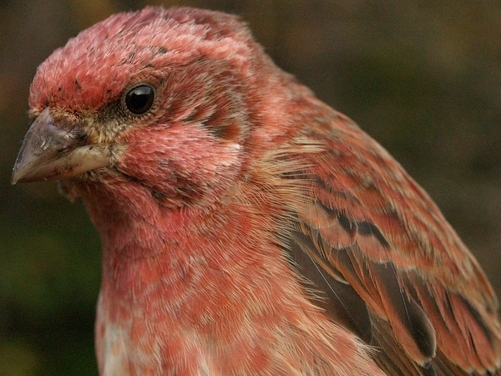 Amid the many House Finches banded this week was this one noticeable interloper, an after-hatch-year male Purple Finch. (Photo by Simon Duval)
Amid the many House Finches banded this week was this one noticeable interloper, an after-hatch-year male Purple Finch. (Photo by Simon Duval)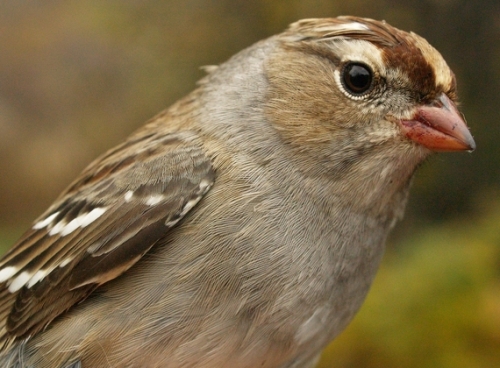 Sparrows accounted for nearly half the species banded at MBO this week, with this late-lingering White-crowned Sparrow the most surprising of the six species. (Photo by Simon Duval)
Sparrows accounted for nearly half the species banded at MBO this week, with this late-lingering White-crowned Sparrow the most surprising of the six species. (Photo by Simon Duval)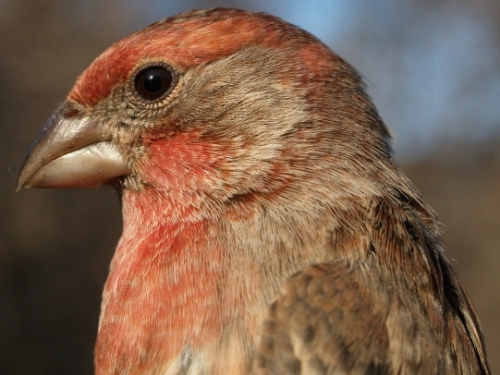 Although House Finch numbers dropped off compared to the first week of November, we still banded several more, including this after-hatch-year male. (Photo by Simon Duval)
Although House Finch numbers dropped off compared to the first week of November, we still banded several more, including this after-hatch-year male. (Photo by Simon Duval)
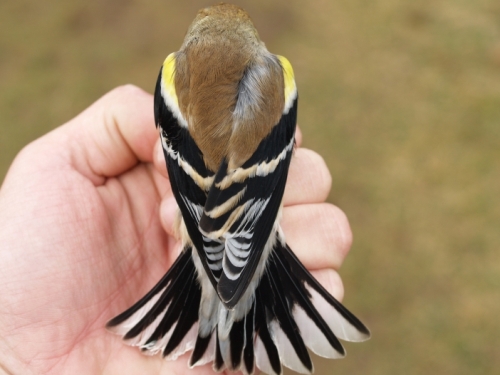 A top view of an after-hatch-year male American Goldfinch, with the tail nicely fanned to show the broad and rounded rectrices with large white patches, and distinctly yellow shoulders also clearly visible. (Photo by Simon Duval)
A top view of an after-hatch-year male American Goldfinch, with the tail nicely fanned to show the broad and rounded rectrices with large white patches, and distinctly yellow shoulders also clearly visible. (Photo by Simon Duval)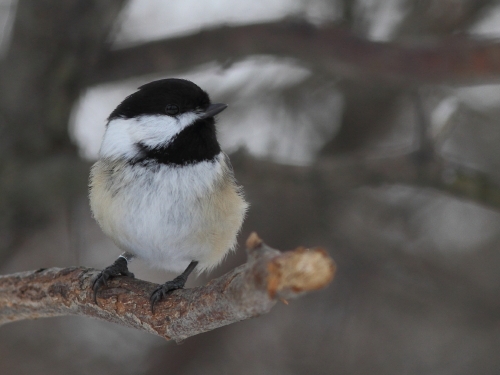 One of our resident banded Black-capped Chickadees hanging out near the feeders. (Photo by Greg Rand)
One of our resident banded Black-capped Chickadees hanging out near the feeders. (Photo by Greg Rand)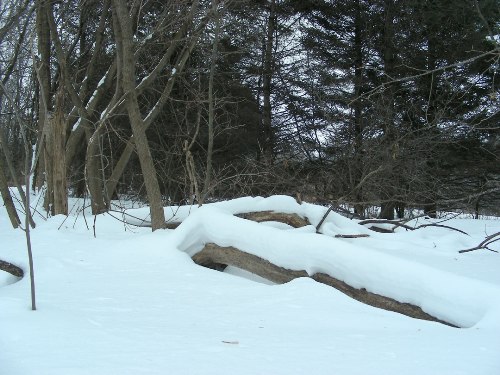 The landscape at MBO has become decidedly winter-like this month. (Photo by Gay Gruner)
The landscape at MBO has become decidedly winter-like this month. (Photo by Gay Gruner)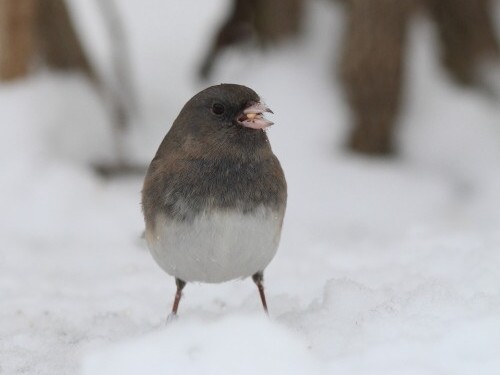 One of the unusually many Slate-colored Juncos wintering at MBO this year. (Photo by Greg Rand)
One of the unusually many Slate-colored Juncos wintering at MBO this year. (Photo by Greg Rand)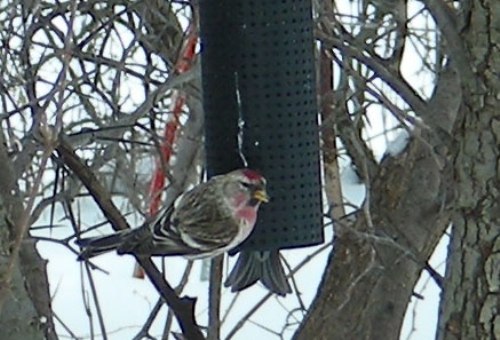 Two (yes, the tail counts!) of the flock of 20 redpolls that arrived near the end of January. (Photo by Gay Gruner)
Two (yes, the tail counts!) of the flock of 20 redpolls that arrived near the end of January. (Photo by Gay Gruner)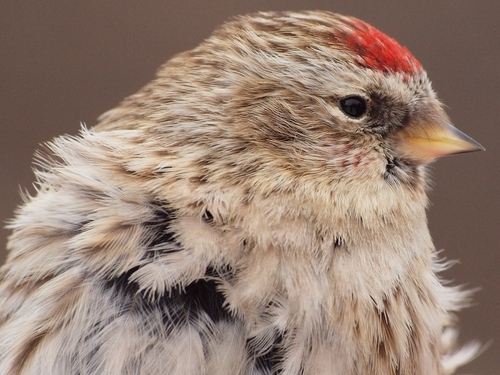 Although weather was again a strong limiting factor in February, we managed to band a few wintering birds, including this Common Redpoll. (Photo by Simon Duval)
Although weather was again a strong limiting factor in February, we managed to band a few wintering birds, including this Common Redpoll. (Photo by Simon Duval)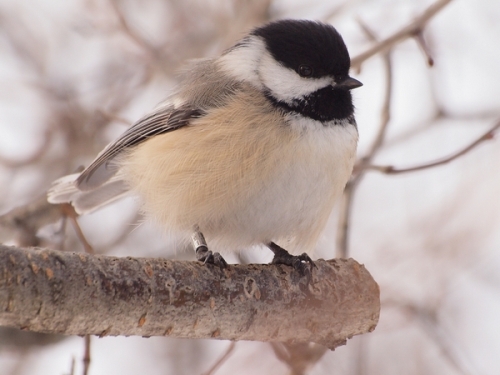 One of our banded resident chickadees hanging out near the feeders. (Photo by Simon Duval)
One of our banded resident chickadees hanging out near the feeders. (Photo by Simon Duval)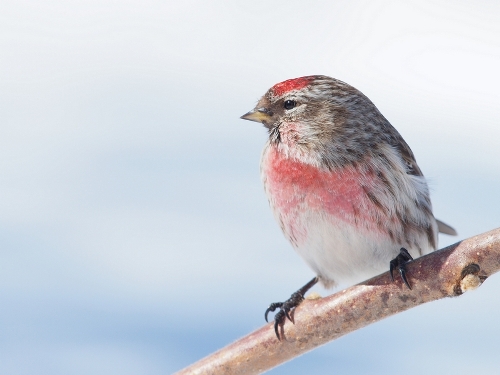 Common Redpolls like this boldly-coloured male remained the dominant species at MBO throughout March. (Photo by Simon Duval)
Common Redpolls like this boldly-coloured male remained the dominant species at MBO throughout March. (Photo by Simon Duval)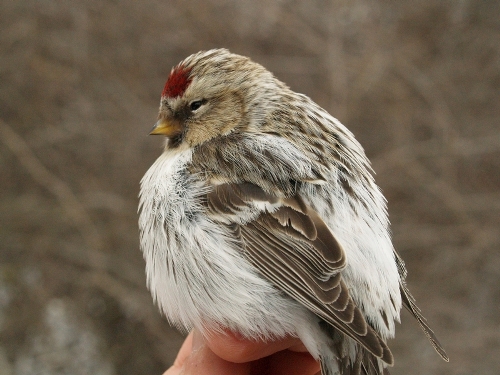 A second-year Hoary Redpoll – the 107th species banded at McGill Bird Observatory. (Photo by Simon Duval)
A second-year Hoary Redpoll – the 107th species banded at McGill Bird Observatory. (Photo by Simon Duval)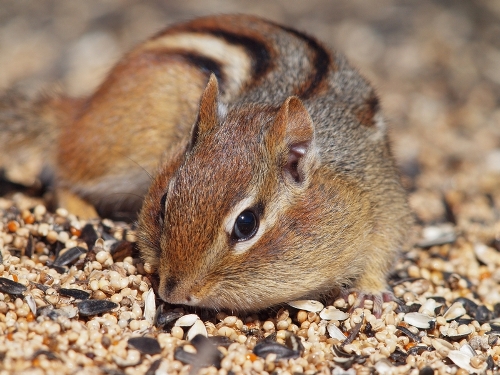 The redpolls aren’t the only ones that have been enjoying our feeders this month, as shown by this “cheeky” chipmunk. (Photo by Simon Duval)
The redpolls aren’t the only ones that have been enjoying our feeders this month, as shown by this “cheeky” chipmunk. (Photo by Simon Duval)